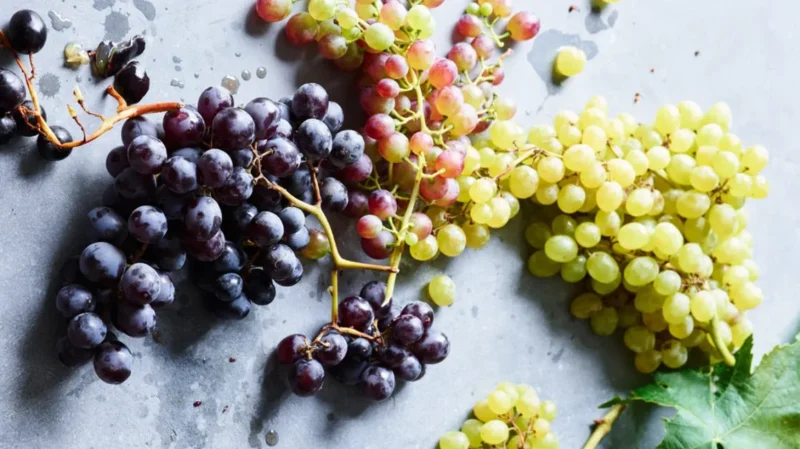Grapes, the versatile fruit known for their snacking potential, are a staple in many households. They can be pressed into juice, transformed into jellies, or baked into desserts. But when is the best time to enjoy them fresh? Let’s dive into the world of grapes and explore their seasonality.
Grapes, often referred to as nature’s candy, are not only a treat for the taste buds but also a powerhouse of nutrition. A single cup of these juicy berries provides a mere 62 calories, making them an excellent choice for those watching their calorie intake. But it’s not just about the calories; it’s about the wealth of nutrients they bring:
- Vitamin K: Essential for blood clotting and bone health, grapes provide a significant amount of this vitamin. Regular consumption can help in preventing excessive bleeding from cuts and can contribute to maintaining bone density.
- Manganese: This trace mineral plays a vital role in the formation of connective tissues, bones, blood clotting factors, and sex hormones. It also plays a part in fat and carbohydrate metabolism, calcium absorption, and blood sugar regulation.
- Potassium: An essential mineral, potassium helps regulate blood pressure, fluid balance, and muscle and nerve signals. A diet rich in potassium can help reduce the risk of stroke, osteoporosis, and kidney stones.
- Vitamin C: Known for its immune-boosting properties, vitamin C also promotes healthy skin, wound healing, and helps the body absorb iron.
- Antioxidants: Grapes are a treasure trove of antioxidants. These compounds help combat oxidative stress and inflammation in the body. One of the standout antioxidants in grapes is proanthocyanidin, which boasts impressive health benefits. Moreover, red grapes are a source of lycopene, a type of antioxidant known for its potential protective effects against certain types of cancers, notably prostate and breast cancer.
Grape Seasonality
While grapes might be available year-round in supermarkets, there’s a distinct period when they’re at their freshest and juiciest. In the U.S., the grape harvest reaches its zenith from August to October. This is when you’ll find the most flavorful and sweetest grapes. However, the exact timing can vary based on the grape variety and the specific region where they’re grown. Some early varieties might make their appearance in markets during the early summer months, while late bloomers might be harvested as the leaves start to fall in late autumn. Being aware of this seasonality ensures you get to enjoy grapes when they’re at their best.
Choosing the Perfect Bunch
Selecting the best grapes isn’t just about grabbing a bunch and heading to the checkout. Here’s a guide to ensure you pick the cream of the crop:
- Appearance: A ripe grape is plump and firm to the touch. The skin should be smooth without any wrinkles or shrivels.
- Color: Depending on the variety, look for vibrant colors. Green grapes should be a pale yellow-green, red grapes should be predominantly red, and black grapes should have a deep, rich hue.
- Stem Health: The stem is a good indicator of freshness. Grapes attached to green and flexible stems are usually fresh. If the stem is woody or brittle, the grapes might have been sitting for a while.
- Avoid Blemishes: Brown spots near the stem, soft or leaking grapes, or any signs of mold are indicators that the grapes are past their prime or weren’t stored properly.
- Taste Test: If possible, taste a grape before buying. It should be juicy and sweet with a slight tartness.
Remember, the best grapes are not just about appearance but also about taste and texture. So, the next time you’re in the market, use these tips to ensure you bring home the best bunch!
Popular Varieties
There are thousands of grape varieties, but here are five common ones:
- Red Flame: A seedless California hybrid that’s large, round, and slightly tart.
- Red Globe: Seedless with red skin and a mild flavor.
- Thompson Seedless: Pale green with a crisp texture and sweet taste.
- Cotton Candy: A hybrid seedless white grape known for its robust sweetness.
- Concord: Blue-colored and often used to produce grape juice, jams, and jellies.
Storing Grapes: Best Practices
Grapes are delicate fruits that require a bit of care to ensure they remain fresh and delicious. Here’s a more detailed guide on how to store them:
- Immediate Storage: When you bring grapes home from the market, resist the urge to wash them right away. Moisture can promote mold growth. Instead, remove any grapes that look shriveled or moldy to prevent them from affecting the others.
- Proper Packaging: While many people store grapes in the plastic bags they come in, it’s beneficial to transfer them to airtight plastic bags or containers. This helps maintain humidity and prevents the grapes from absorbing odors from other foods in the refrigerator.
- Optimal Refrigeration: Grapes prefer cold temperatures. Store them in the crisper drawer of your refrigerator, where the temperature is consistent.
- Consumption Time: While grapes can last up to a week when stored correctly, it’s best to consume them within a few days for optimal flavor and texture.
- Washing: Always wash grapes under cold running water just before eating or using in recipes. As they might have residues of insecticides or other chemicals, it’s essential to rinse them thoroughly. Consider using a mixture of vinegar and water to soak and clean them, as this can help in removing residues more effectively.
Culinary Adventures
Grapes have been a favorite snack for centuries, but their culinary uses extend far beyond just popping them into your mouth. Here’s a deeper dive into how you can incorporate grapes into various dishes:
- Salads: Grapes can add a juicy, sweet element to salads. Consider pairing them with nuts like walnuts or almonds, cheeses like feta or blue cheese, and a light vinaigrette for a refreshing dish.
- Roasting: When roasted, grapes undergo a transformation. Their sugars caramelize, and they take on a deeper, richer flavor. Try roasting them with chicken or pork, or even on their own with a drizzle of olive oil and a sprinkle of salt.
- Desserts: Grapes can be the star of many desserts. From the rustic Grape Almond Cobbler to the more refined Grape-Vanilla Tartlets, they bring sweetness and texture. They can also be used in sorbets, ice creams, or even as a fresh topping for cakes and pastries.
- Drinks: Grapes can be muddled into cocktails, blended into smoothies, or even frozen to be used as ice cubes in summer drinks. For a classic choice, add them to sangrias, where they soak up the wine and other flavors, becoming little bursts of joy in the drink.
- Sauces and Jams: Grapes can be cooked down into sauces, perfect for drizzling over meats or desserts. Alternatively, they can be turned into jams and jellies, capturing their sweetness to be enjoyed throughout the year.
FAQs
Can I freeze grapes for longer storage?
Yes, grapes can be frozen and make for a delightful frozen snack, especially in the summer. Simply wash, dry, and spread them on a baking sheet to freeze individually. Once frozen, transfer them to a freezer bag. They can be eaten frozen or used as ice cubes in drinks.
Are organic grapes better than conventionally grown ones?
Organic grapes are grown without synthetic pesticides and fertilizers. While they might have fewer pesticide residues, it’s essential to wash all grapes, organic or not, before consumption. Some people believe organic grapes have a better flavor, but this can be subjective.
What’s the difference between table grapes and wine grapes?
Table grapes are bred for direct consumption and are typically larger, seedless, and have thinner skins. Wine grapes are smaller, have seeds, and thicker skins, which contribute to the flavor and color of wines. They might be too tart for regular snacking.
Can I grow grapes in my backyard?
Yes, with the right conditions. Grapes require a lot of sunlight, well-draining soil, and some varieties need a colder winter to thrive. It’s essential to choose a grape variety suitable for your climate and to provide proper care and pruning.
How can I tell if my grapes have gone bad besides visual signs?
Grapes that have gone bad may have a sour or off-putting smell. If they feel slimy or mushy when touched, it’s best to discard them. Always trust your senses; if something seems off, it’s better to be safe and not consume them.
Are grape seeds edible, and do they have any health benefits?
Yes, grape seeds are edible, though they might taste slightly bitter. They are rich in antioxidants, including oligomeric proanthocyanidin complexes (OPCs), which are believed to have numerous health benefits, including supporting heart health and reducing inflammation. Some people choose to consume grape seed extract supplements for these benefits.
Conclusion
Grapes, often dubbed as nature’s tiny treasures, are more than just bite-sized delights. From their rich nutritional profile to their versatile culinary applications, they truly are a testament to the saying, “Good things come in small packages.” Whether you’re snacking on them straight from the vine, incorporating them into a gourmet dish, or sipping them in a refreshing beverage, grapes never cease to amaze.
As we continue to discover their myriad benefits and uses, one thing remains clear: grapes are a timeless fruit, deserving of their cherished spot in our diets and hearts. So, the next time you enjoy a grape, take a moment to appreciate the vast world of flavor and nutrition packed into that tiny orb. Cheers to the enduring magic of grapes! 🍇



